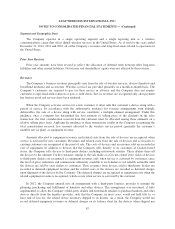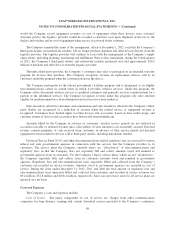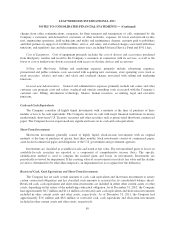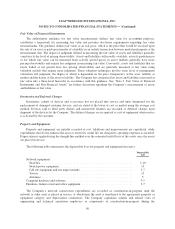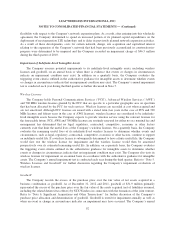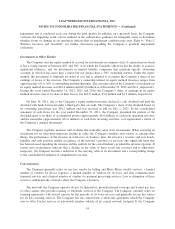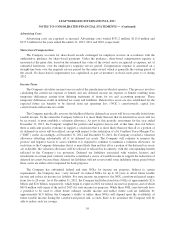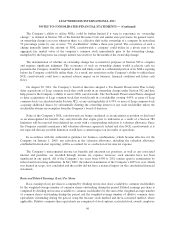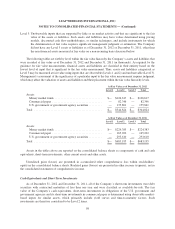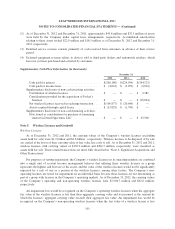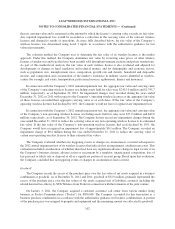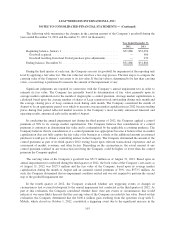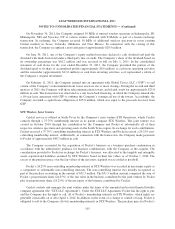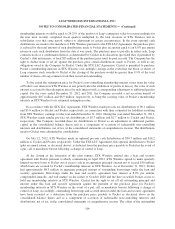Cricket Wireless 2012 Annual Report Download - page 111
Download and view the complete annual report
Please find page 111 of the 2012 Cricket Wireless annual report below. You can navigate through the pages in the report by either clicking on the pages listed below, or by using the keyword search tool below to find specific information within the annual report.LEAP WIRELESS INTERNATIONAL, INC.
NOTES TO CONSOLIDATED FINANCIAL STATEMENTS — (Continued)
stock purchase rights and convertible senior notes. Since the Company incurred losses for the years ended
December 31, 2012, 2011 and 2010, 8.4 million, 7.8 million and 9.4 million common share equivalents were
excluded in the computation of diluted loss per share for those periods, respectively.
Recent Accounting Pronouncements
In July 2012, the Financial Accounting Standards Board (“FASB”) issued Accounting Standards Update
No. 2012-02, “Testing Indefinite-Lived Intangible Assets for Impairment” (“ASU 2012-02”). ASU 2012-02
simplifies the requirements for testing for indefinite-lived intangible assets other than goodwill and permits an
entity to first assess qualitative factors to determine whether it is necessary to perform a quantitative fair value
test. This new guidance is effective for the Company beginning in the first quarter of 2013 and will be applied
prospectively. The Company anticipates that the adoption of this standard will not have a material impact on the
Company or its consolidated financial statements.
Note 3. Fair Value of Financial Instruments and Non-Financial Assets
Fair Value of Financial Instruments
The authoritative guidance for fair value measurements defines fair value for accounting purposes,
establishes a framework for measuring fair value and provides disclosure requirements regarding fair value
measurements. The guidance defines fair value as an exit price, which is the price that would be received upon
the sale of an asset or paid upon the transfer of a liability in an orderly transaction between market participants at
the measurement date. The degree of judgment utilized in measuring the fair value of assets and liabilities
generally correlates to the level of pricing observability. Assets and liabilities with readily available, actively
quoted prices or for which fair value can be measured from actively quoted prices in active markets generally
have more pricing observability and require less judgment in measuring fair value. Conversely, assets and
liabilities that are rarely traded or not quoted have less pricing observability and are generally measured at fair
value using valuation models that require more judgment. These valuation techniques involve some level of
management estimation and judgment, the degree of which is dependent on the price transparency of the asset,
liability or market and the nature of the asset or liability.
The Company has categorized its assets and liabilities measured at fair value into a three-level hierarchy in
accordance with the authoritative guidance for fair value measurements. Assets and liabilities measured at fair
value using quoted prices in active markets for identical assets or liabilities are generally categorized as Level 1;
assets and liabilities measured at fair value using observable market-based inputs or unobservable inputs that are
corroborated by market data for similar assets or liabilities are generally categorized as Level 2; and assets and
liabilities measured at fair value using unobservable inputs that cannot be corroborated by market data are
generally categorized as Level 3. Assets and liabilities presented at fair value in the Company’s consolidated
balance sheets are generally categorized as follows:
Level 1: Quoted prices in active markets for identical assets or liabilities. The Company did not have any Level 1
assets or liabilities as of December 31, 2012 or December 31, 2011.
Level 2: Observable inputs other than Level 1 prices, such as quoted prices for similar assets or liabilities, quoted
prices in markets that are not active or other inputs that are observable or can be corroborated by
observable market data for substantially the full term of the assets or liabilities. The Company’s Level 2
assets as of December 31, 2012 and December 31, 2011 included its cash equivalents, its short-term
investments in obligations of the U.S. government and government agencies and its short-term
investments in commercial paper.
97


